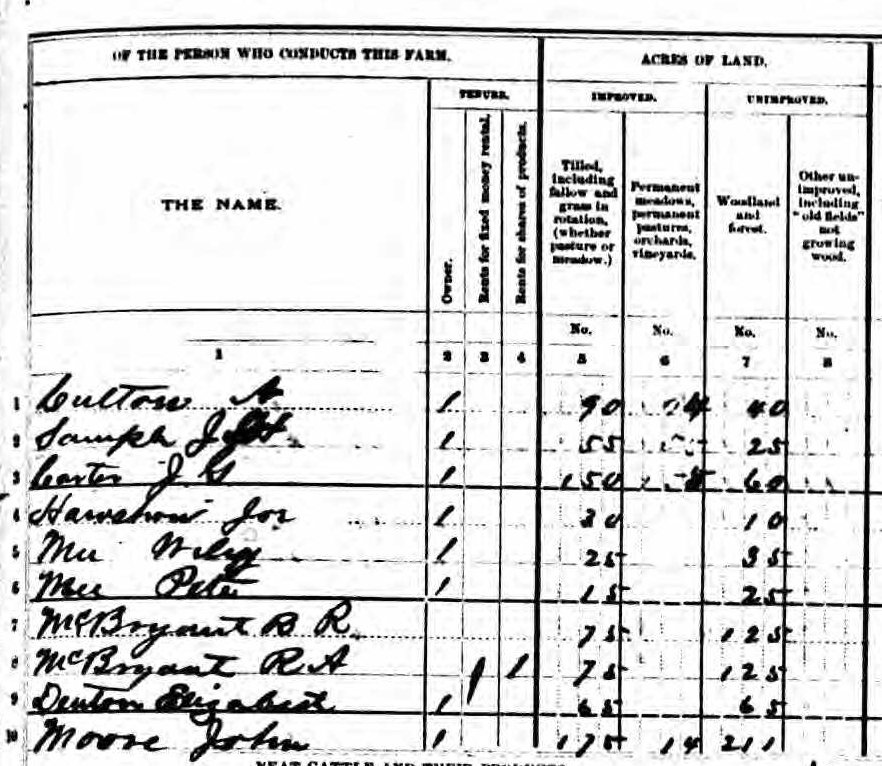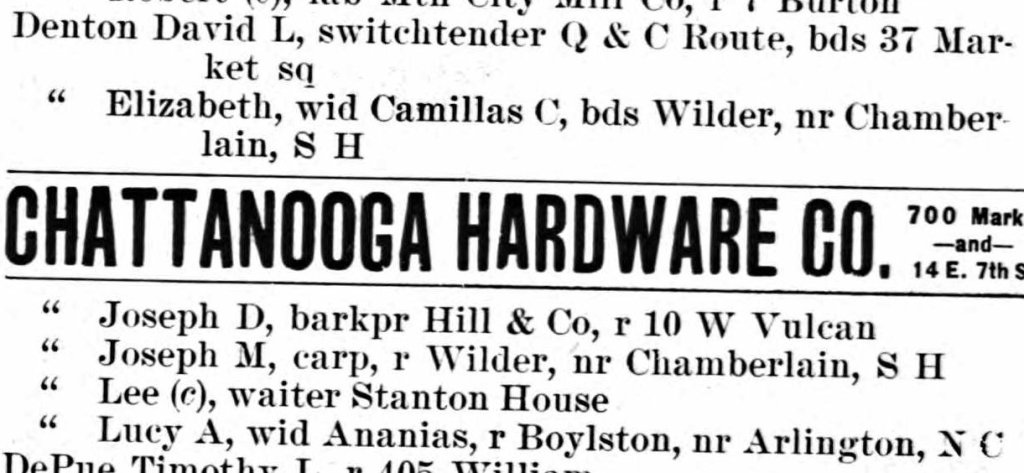A recent find of a pension application in the Georgia Digital Archive shed a lot of light into the life story of this Tennessee Civil War widow. A sketch of her life, with sources, is given here. Any corrections or additions, with sources, are welcome and will be incorporated. A separate post on her husband will be coming soon.
Elizabeth PICKENS was born on Oct 2, 1828 in Blount County, Tennessee (1), to John PICKENS and Nancy (maiden name unknown). Her brother Joseph PICKENS and sister Letta PICKENS would have been 18 and 14, respectively (2). Letta appeared to have some special needs, and lived her life not being able to read or write in an otherwise literate family. (3,4,5) If there were other siblings, they are not known at this time. John and Nancy were 40 and 39 at the time of Elizabeth’s birth, and it appears that Elizabeth might have been the baby of the family, with no children following (2).

In early 1840, her father John applied to purchase 80 acres of land in nearby Bradley County, which was being partitioned for settlement in the wake of the tragic Cherokee Trail of Tears. His purchase was approved later that year (6), and it can be presumed that the family would have moved there sometime soon after, when Elizabeth was 12 or 13. This land was likely undeveloped, and turning it into a working farm would have been a very large effort for this family. Joseph and Letta both came along.

In 1850, John and Joseph are both listed as farmers on John’s farm, valued at $1200. (2) In 1850, the average value of land in Bradley county was $6 an acre (7), so their farm either would have been considerably improved, or perhaps they purchased additional land to their original 80 acres, or it simply sat on desirable land. Elizabeth was 21 at this time, and had undoubtedly spent her teenage years working hard at the family farm.

Neighbors to the Pickens family were the families of Greenbury DENTON and Leonard DENTON. Elizabeth would meet and be courted by a Camillus Cornelius DENTON (alt. Camillas, Camelias), perhaps while visiting with her neighbor Dentons, or perhaps Camillus had moved to Bradley county himself sometime after 1850. They were married on January 14, 1856 in Bradley County (1). Elizabeth was 27, Camillus was 34. Children came right away, and by the time of the 1860 census, Elizabeth and Camillus were living most probably on land originally belonging to Greenbury or Leonard. They were right next to Elizabeth’s parents, brother, and sister, and they were raising 2 young sons, 4 year-old John DENTON and 2 year-old Joseph DENTON, names following Elizabeth’s father and older brother. Also in the household is listed a 4 year-old girl named Esther, who is identified as mulatto. (3) Nothing more is known about Esther, and she was not listed with the family 10 years later.

A third son, Samuel DENTON, was born about 1861. Little Joseph would not live long, probably dying before he was older than 5. (4) Their last son Joseph Martin DENTON, born on New Year’s day in 1863 (8), was given the name of his recently departed brother.
The Civil War began in 1861, and portions of Bradley county would be army-occupied through almost the entire length of the war, by one side or another. The Confederacy passed a conscription law in April of 1862, requiring able-bodied men 18 to 35 to three years of service. Camillus was 40 at the time, and they were busy with 3 or 4 young boys, and the farm to run. Bradley county, and eastern Tennessee generally, was opposed to secession. It is unknown where the Denton’s sympathies laid. Unionists, such as there were, were under intense governmental pressure in the Confederacy, and joining the Confederate army did not necessarily equate to support for the Confederate cause, particularly in East Tennessee. The Confederate draft was soon expanded to include older men, and Camillus enlisted with the Tennessee Infantry in August of 1863. (1) Elizabeth was 34, had been married for 7 years, had already buried a son, and had 3 boys aged 6 years, 2 years, and 7 months. Now her husband was leaving for war, with Elizabeth to take care of the farm.

Elizabeth and Camillus wrote at least a few times. However, she was never to see her husband again. He was captured in Virginia in June of 1864 and taken to Point Lookout prison camp in Maryland. The last communication Elizabeth received was a brief letter from Camillus from the prison camp, shortly after his capture. She never heard any further definite news, so she must have waited and hoped for his safe return. (1) The war ended in April of 1865, but he did not return. Elizabeth had been left a widow, with 3 small boys and a farm to manage.

By 1870, Elizabeth’s parents had also both died, but her brother Joseph was still living next-door, taking care of Letta. Elizabeth was listed on the census with her boys, 13 year-old John doing “Farm labour.” (4)

Over the next decade, her boys grew up, Samuel left home, and her brother Joseph passed away. In 1880, Elizabeth was 51 with sons John and Joseph at home, and caring for her older sister Letta. (5)

The 1880 US Census Agricultural schedule gives us a sense for her farm, which was likely a combination of the one she grew up on, and the one that she and Camillus had started after marriage. 130 acres of mixed farm and forestland, a horse, a donkey, and a milk cow. Over the prior year she had purchased 12 cows, sold 15, and slaughtered 2. She had made 150 pounds of butter. 3 pigs, 20 chickens (producing 150 dozen eggs per year). 30 acres of corn, 25 of wheat, 50 apple trees and 50 peach trees, bees enough to produce 100 pounds of honey a year (perhaps 4 hives), and harvested 25 bushels of cowpeas. She had harvested 30 cords of wood from her forest. Overall, hers was a fairly typical farm for it’s area and time, providing for her family and producing a variety of products for sale or barter. (9)

The information in the 1890 census is lost to us, but we know Elizabeth must have sold the farm at some point. In 1891, Elizabeth lost the use of one of her hands in a fall. (1) Perhaps this would have prompted the sale of the farm.

In 1892, Joseph Martin was living in Chattanooga as a carpenter. Elizabeth and John would soon follow, and two years later we find them in the Chattanooga city directory as well, John working as a contractor and Elizabeth, now 64, living with John. The next year 1895, Joseph Martin moved in with Elizabeth, and John appears to have moved out. The Cotton States and International Exposition was held in Atlanta in 1895, and Joseph took his family to visit. Joseph continues to be listed in Chattanooga in 1896, but Elizabeth moved to Atlanta in October of that year. By 1897, Joseph has also left Chattanooga, moving to Atlanta. (11)

Now in her 70s, Elizabeth was living with Joseph’s family in Atlanta in 1900. (12) In 1901, she filed for a widow’s pension for reasons of age and poverty. By this time, it appears her personal property had dwindled to basically nothing. Responding to a question on the pension application, she stated “I hav a Bed and wareing Close is all”

She was unable to work and was being supported by John and Joseph completely. (1) She appeared to share occupancy between the two.

At the age of 79, Elizabeth passed away on November 24, 1907 in Atlanta, at her son Joseph’s house. She was taken back to Tennessee for funeral and burial. (13)

Future Directions
There are still several questions unanswered, and perhaps approachable with a little more research:
- A more exact description of Elizabeth’s early childhood. Where was she born in Blount county? Did she grow up with other siblings nearer her age?
- More information about the family farm. It was probably located around Charleston, but based on John’s land application, and census data, it should be possible to figure out the exact location.
- How was Camillus related to Greenbury and Leonard? Did he move to Bradley county and buy the neighboring farm before he met Elizabeth?
- Who is Esther, and what became of her after 1860?
- Was the farm impacted by Confederate or Union troop occupation in the area?
- Elizabeth submitted several letters from Camillus in her pension application. Did she keep others and are they still held by a descendant?
- What became of Samuel?
- Bradley County court record indices indicate two court cases between Elizabeth and her sister Letta. Joining Letta’s side in the cases is an R.J. Cate. Perhaps this is about guardianship? This trail has not yet been explored.
- Where is Elizabeth buried? Likely in McMinn or Bradley county, but the cemetery is unknown.
Sources
While some clipped images are included within the sketch, Elizabeth’s FamilySearch page has been updated with most of the below sources for more complete information. Her FamilySearch ID is L788-V58.
- Widow’s pension
- 1850 Census
- 1860 Census
- 1870 Census
- 1880 Census
- Tennessee Land Records
- Farm real estate values in the United States by counties, 1850-1982/ Charles H. Barnard, John Jones.Barnard, Charles H.Washington, D.C. : U.S. Dept. of Agriculture, Economic Research Service, 1987.
- Death certificate of Joseph M DENTON
- 1880 Census Agricultural Schedule
- Personal narrative of Myrtle Fay DENTON
- Chattanooga City Directories, 1892 – 1897
- 1900 Census
- Atlanta Georgian Newspaper, Nov 25 and 26, 1907
